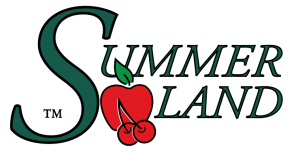Apple Clearwing Moth
General Description
The apple clearwing moth (known as small red-belted clearwing moth in Europe) was confirmed in Cawston in 2005 on apple as the first record in North America. It has since spread throughout the Similkameen valley and to different areas of the Okanagan valley. It is also present in Coastal B.C. and one orchard in Ontario. Growers should report any suspicious damage to their field service/crop advisor to confirm if this pest is present in their orchard. TO STOP THE SPREAD OF THIS NEW PEST, DO NOT MOVE FRUIT TREES, ROOTSTOCKS, AND APPLE WOOD FROM INFESTED AREAS.
Hosts
European hosts include apple, pear, crabapple, quince, plums, apricots, cherries, hawthorn, and mountain ash, but in Canada it has only been found in apple trees.
Damage
Larvae tunnel under the bark anywhere from below the crown area up to branches. They enter the trunk through burr knots, wounds, grafts, branch collars, pruning cuts, and wire-damaged areas (Figs. 1 & 2), causing infested areas to swell (Fig. 3).
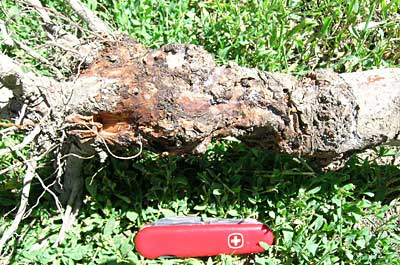 |
|
| Figure 1. Damage from wires. (A. Brown) | Figure 2. Larval damage to crown area of young apple tree (H.Philip) |
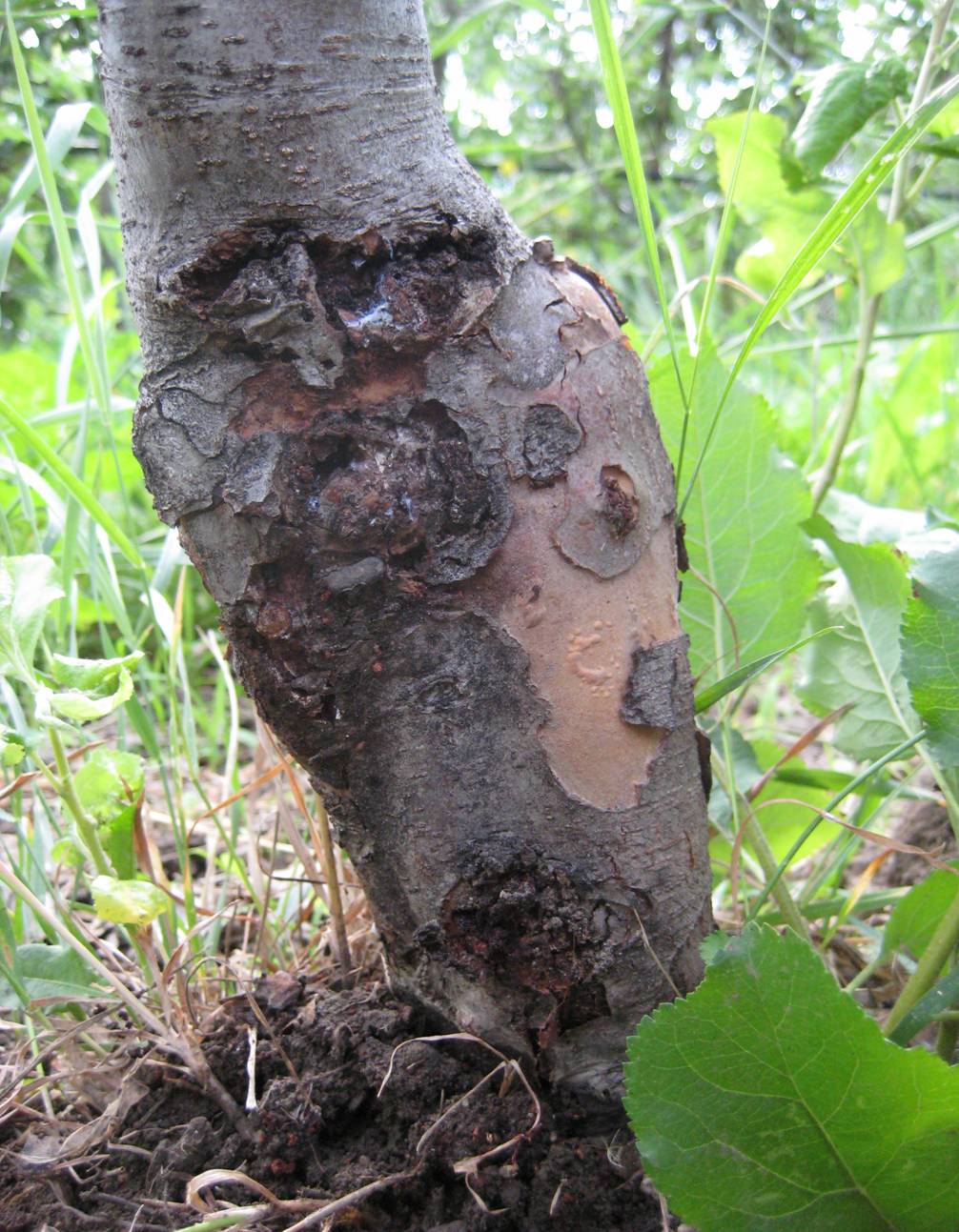 |
| Figure 3. Swollen infested rootstock. (A. Brown) |
Infestations have been found mainly in M9, M26 and Ottawa 3 rootstocks below the graft union and under burls or around cankers above the graft union, but all apple rootstocks and varieties are attacked. Top-grafted trees are more susceptible to attack and feeding by larvae can kill young trees. Secondary damage in young trees includes weak limbs, poor fruit set and early leaf drop. In the drier desert climate of the Southern Interior of B.C., infested trees are prone to drought stress which can contribute to death of trees. In highly infested orchards, damage can spread throughout tree canopies and central leaders of high-density plantings are heavily attacked after being pruned to control growth. In Europe, apple clearwing moths shorten the life of trees and could make the trees susceptible to attack by other insects such as shothole borer and ambrosia beetle. Infestations are often associated with European canker casued by Nectria galligena.
Identification
Larva: about 15 - 20 mm long, dirty white with reddish-brown head and thoracic shield behind head (Fig. 4).
| Figure 4. Apple clearwing larva with frass. (BC Tree Fruits Cooperative) |
Pupa: 15 mm long, pale yellowish-brown (Fig. 5).
| Figure 5. Apple clearwing moth cocoon (Left) and pupa (right). (H. Philip) |
Adult: 20-25 mm wing-span, slender dark blue-black body with orange-red band across the abdomen. Wings are transparent (lack scales), the front pair narrow, shiny and slightly dark; hind wings are much shorter (Fig.6).
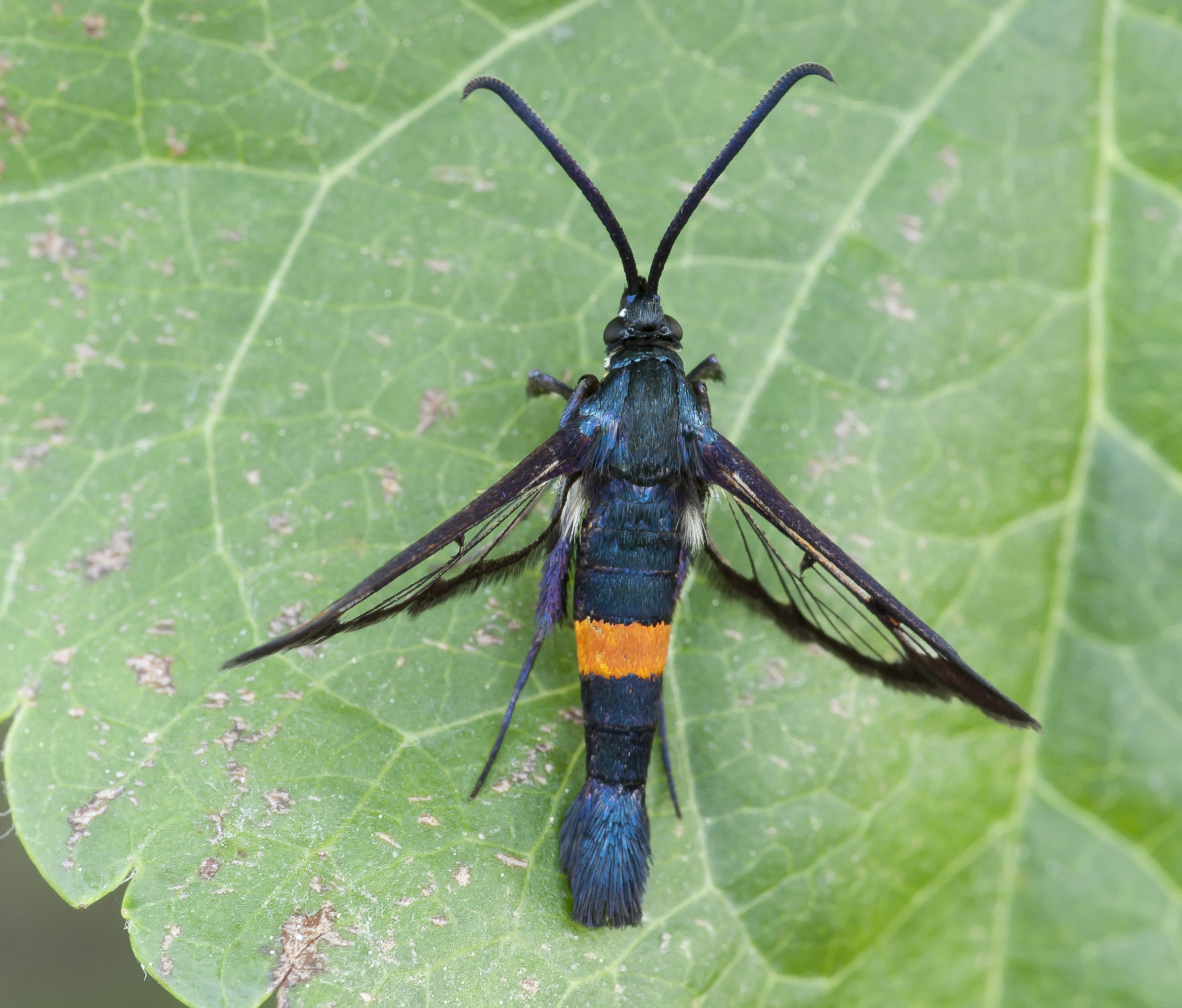 |
| Figure 6. Apple clearwing moth adult. (G. Judd, AA-FC) |
Life History
In the Similkameen and Okanagan Valleys, apple clearwing moth has a 2-year life cycle. Adult flight begins in early June, peaks by mid July and ends in late August. Male emergence peaks about 1 week before that of female moths. Females feed on nectar for a few days before laying eggs. Eggs are laid singly in burr knots, pruning cuts and wounded bark on branches and trunks, and likely any other site that allows larvae to get under the bark. As populations intensify within an orchard, females seek egg-laying sites higher up in the canopy. Larvae feed on sap between the bark and inner tissue (cambium layer) of trees for almost two years before pupation. Larval feeding leads to the creation of shallow, irregular winding galleries just cutting into the wood, and about 20 – 25 mm long. Frass collects in feeding tunnels but is expelled by larvae in spring just before they pupate. The larvae overwinter in the tunnels and pupate the following spring at the entrance of the tunnels.
When the moths are ready to emerge (mostly in the morning), the pupae wriggle to the tunnel exit hole and extend out to allow the adults to emerge. The appearance of empty pupal cases sticking out of the bark is a useful indication of its presence (Fig.7). Counts of pupal cases can be used to estimate population density. There is one generation per year.
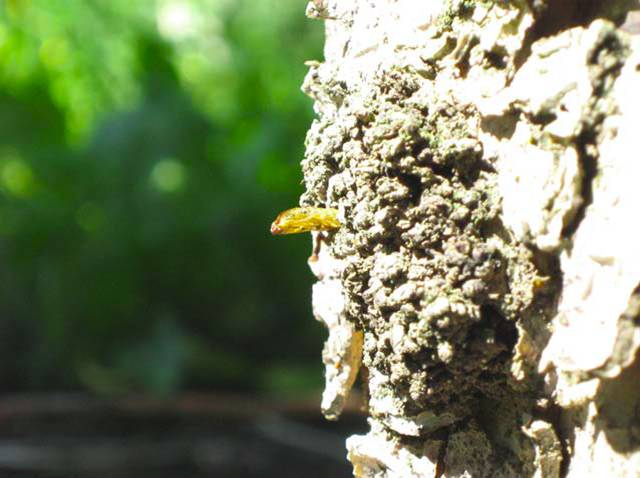 |
| Figure 7. Apple clearwing pupal case. (BC Tree Fruits Cooperative) |
Monitoring
To check for larval infestations, look for signs of reddish brown frass at the bases of trees, especially rootstocks that appear abnormally swollen, aerial roots, pruning scars, branch collars, graft unions and weak trees in the spring (April to early May). Examine the bases of trees for 2 to 3 mm-wide holes and tunnels under the bark. Look for pupal cases to determine infestation levels. Moths may be observed resting on leaves during sunny days in late spring. Set up Unitraps (Fig. 8) or delta or wing traps (Fig. 9) baited with peach tree borer pheromone by late May to monitor adult male apple clearwing moths.
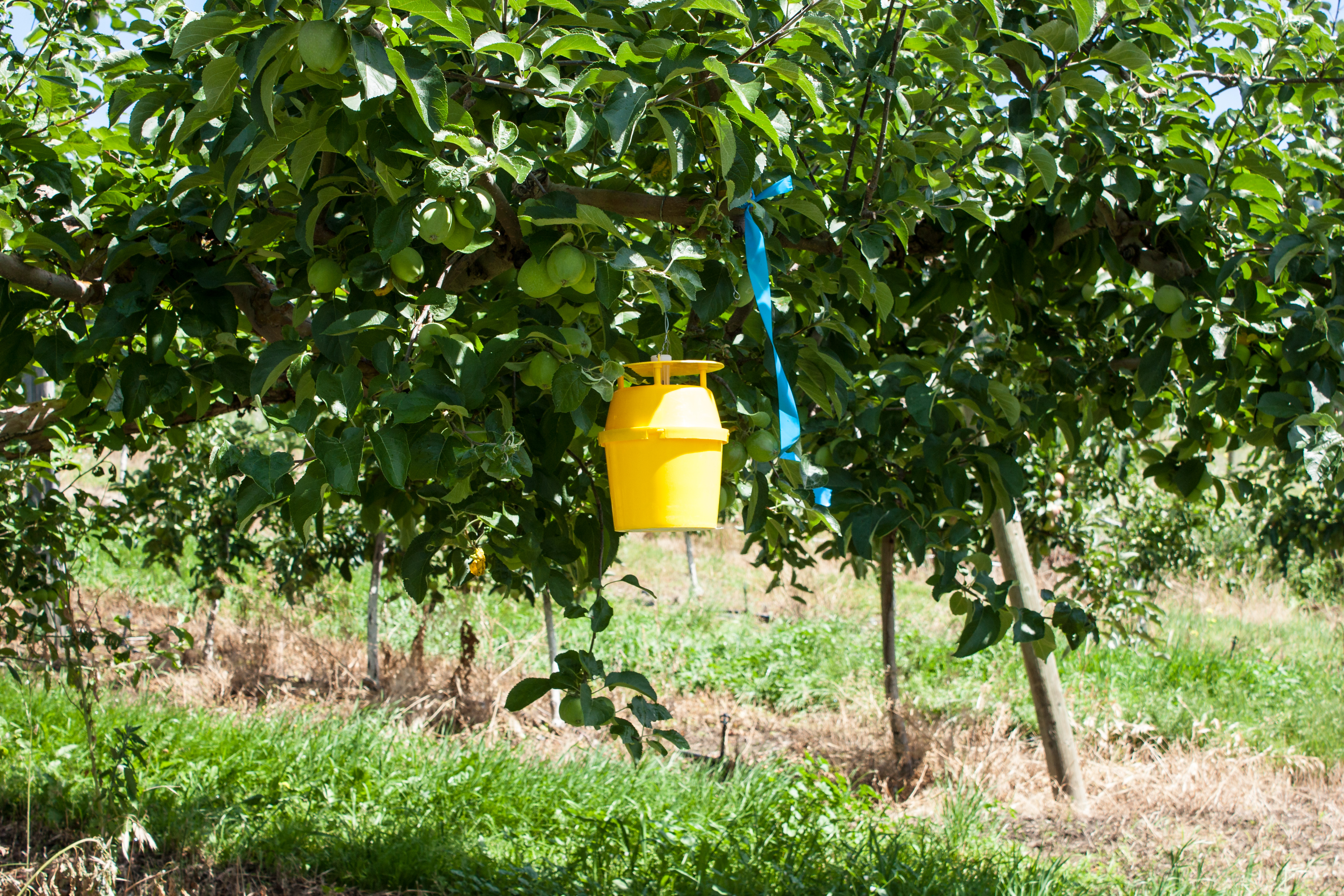 |
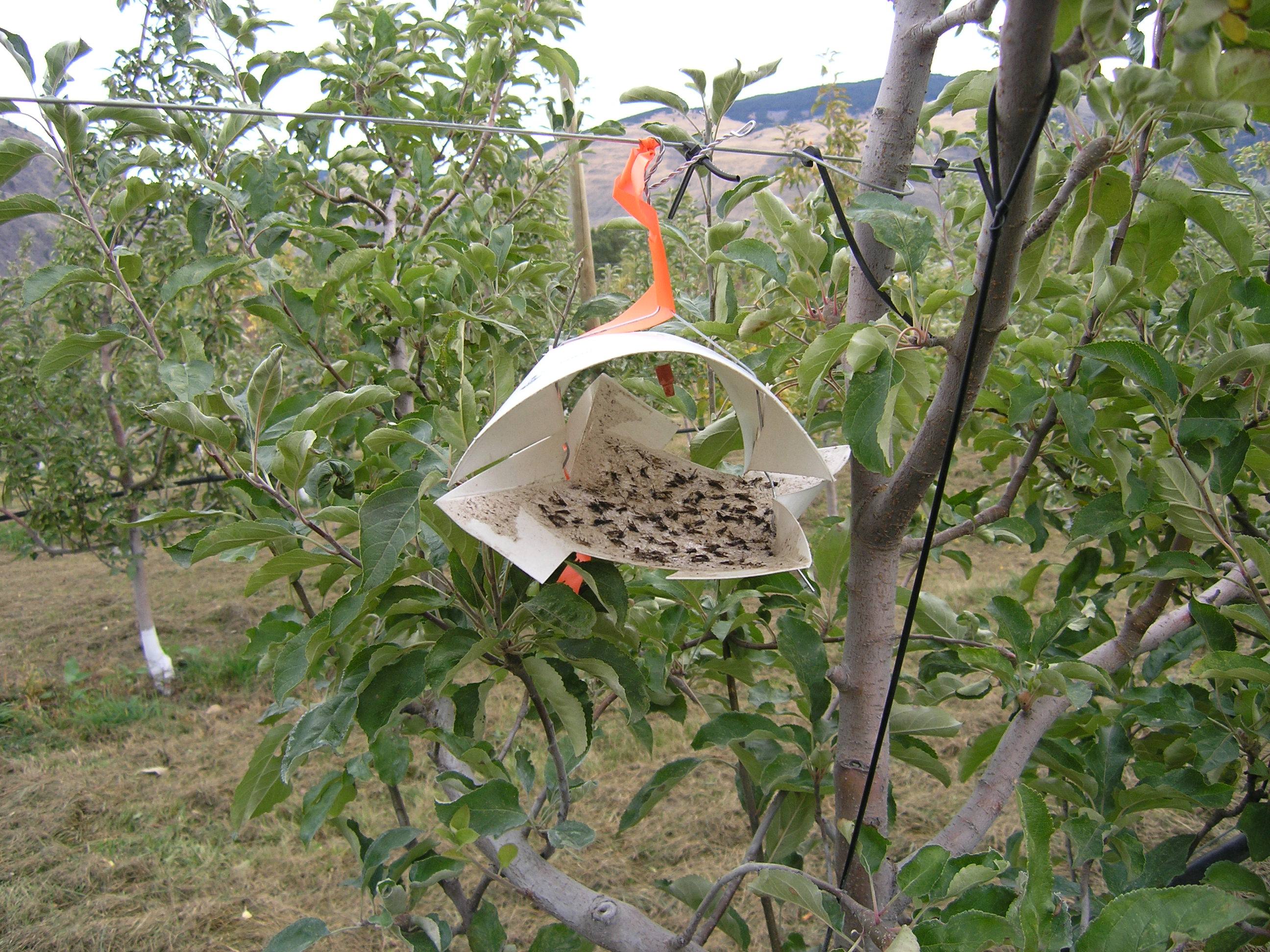 |
| Figure 8. Unitrap hung in apple tree. | Figure 9. Wing trap with captured moths. (G. Judd, AA-FC) |
NOTE: Pheromone-baited traps will not work in mating disruption-treated orchards. Growers should look for larval infestations and/or pupal cases to determine the prevalence of ACM in these orchards.
Neighbourhood Maps displaying the distribution and abundance of ACM in apple orchards throughout the Okanagan Valley are posted at www.oksir.org/orchard-information/2016-survey-maps/.
Management
Biological Control
Earwigs, ants, spiders and birds will feed on larvae. Birds cause damage to the bark of trees during feeding and this may kill trees.
Cultural Control
According to European sources, reduce the risk of infestations by minimizing wounds to trees, removing young trees with cankers, and sealing wounds with wound-protecting products. Tree guards, trunk wraps, and soil mounding are not effective and probing trees with metal wires to kill larvae will damage trees (Gary Judd, AAFC, Summerland).
Mass trapping - Two litre plastic bottle traps (Figs.10 & 11) baited with grape juice are highly attractive to both male and female clearwing moths (Gary Judd, AAFC, Summerland).
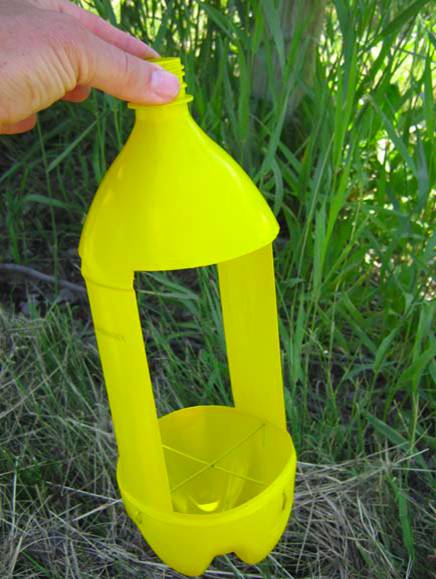 |
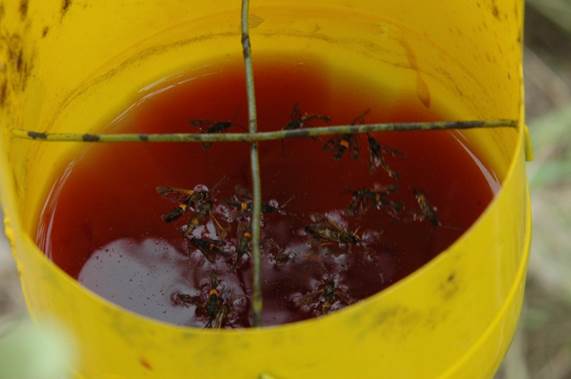 |
| Figure 10. Apple clearwing moth bottle trap (BC Tree Fruits Cooperative) | Figure 11. Moths captures in grape juice-baited bottle trap. (G. Judd, AA-FC) |
Two litre honey buckets can be used instead of plastic bottles. Moths should be cleared out of traps regularly. A bait of 8 L Water + 1 L apple juice + 1 L vinegar + 100 g sugar has been found to be effective at reducing moth populations in Tyrol, Italy. Use an open bucket (such as a 2-litre honey bucket) to allow for easy clearance of trapped moths with a sieve. Remove moths weekly and top up bait as needed.
Mating disruption - Mating disruption with Isomate-P dispensers can be used for areas with very low levels of apple clearwing moth (orchards that captured less than 25 moths/trap the previous season). Mating disruption programs will be more successful if all growers in the area participate. The dispensers should be applied at 100/acre and hung at head height, 5-6 feet. Isomate-P dispensers are only effective for one season of control.
Chemical Control
Control weeds and irrigate trees prior to spraying. For best control, do not water trees for as long as possible after spraying. Use high water volume and high pressure sprays and saturate trees to run off. Target larvae before pupation in the spring (April to early May, look for signs of frass). Apply summer sprays at 25% and 75% egg laying; 200 and 375 DD (10°C base temp), respectively, after first male pheromone trap catch (Biofix). In the South Okanagan, first summer sprays are generally applied at peak adult trap captures (July 10-15). Repeat spray applications at 7-14 day intervals depending on the product. Check with your field service person or consultant for timing of spray applications.
Spray application technique and coverage are very important. Recommended insecticides should be applied with a hand gun or backpack sprayer at high water volumes to ensure thorough coverage of tree trunks and scaffold limbs. If using a boom sprayer, reduce speed and use one of the following recommended sprayer settings based on 10’ row spacing (BCFGA, Tamara Richardson, 2019):
- 2.0 MPH, 2- #8 nozzles w/45 swirl plates at 130 psi = 3.0 gpm
- 2.5 MPH, 2- #7 nozzles w/56 swirl plates at 60 psi = 3.7 gpm
Apply a minimum of 150 US gal (567 L) per acre.
Apply Rimon in the spring or fall (September) to control larvae. Summer applications of Rimon are not recommended due to mite flare ups.
In areas of high apple clearwing moth populations, the pest moves into the tree canopy and larvae enter pruning scars. Altacor used for the control of leafrollers will help reduce apple clearwing moth populations in aerial parts of the tree.
Registered products for control of apple clearwing moth include Entrust SC (364 mL/ha), Entrust 80 W (75 g/ha), Success 480 SC (125 mL/ha), Delegate (420 g/ha) and Rimon 10EC (1.4 L/1000 L of water/ha) and Altacor MaX (143 g/ha).
For organic growers, use Entrust at a rate of 250 mL of product in 1500 L of water/ha for gun sprays.
See pesticide usage (top left menu) for additional information on products.
